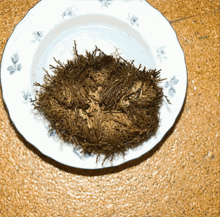| Revision as of 20:57, 6 March 2013 editPlantdrew (talk | contribs)Autopatrolled, Extended confirmed users, New page reviewers645,696 editsNo edit summary← Previous edit | Revision as of 18:20, 31 May 2013 edit undo86.185.41.157 (talk) →See alsoNext edit → | ||
| Line 24: | Line 24: | ||
| * ] | * ] | ||
| * '']'', the resurrection fern | * '']'', the resurrection fern | ||
| The resuuractio gdgjhg | |||
| ==References== | ==References== | ||
Revision as of 18:20, 31 May 2013
A resurrection plant is a generic term used for poikilohydric plants that can survive extreme dehydration, typically even over months or years.

Examples include
- Anastatica hierochuntica, also known as the Rose of Jericho, a plant species native to deserts of North Africa
- Asteriscus (plant);
- Boea hygrometrica
- Haberlea rhodopensis
- Mesembryanthemum.
- Tillandsia
- Myrothamnus flabellifolius, a plant species native to Southern Africa
- Ramonda serbica, a species in the Gesneriaceae family
- Selaginella lepidophylla, a plant species native to North America, Central and South America, and sold as a novelty
- Lichen, a symbiosis that can survive in extreme desiccation
Certain resurrection plants have long been sold in their dry, "lifeless" form as curiosities. This custom was noted by many 19th century authors, and continues today.
See also
- Dehydration
- Cryptobiosis
- Anhydrobiosis
- Dinosaur plant
- Hygrochasy
- Pleopeltis polypodioides, the resurrection fern
The resuuractio gdgjhg
References
- ^ Liberty Hyde Bailey (1916). The Standard Cyclopedia of Horticulture. Vol. 5. The Macmillan company. pp. 2920–2921, 3639.
- Attention: This template ({{cite doi}}) is deprecated. To cite the publication identified by doi:10.1371/journal.pone.0030531, please use {{cite journal}} (if it was published in a bona fide academic journal, otherwise {{cite report}} with
|doi=10.1371/journal.pone.0030531instead. - "Resurrection Plant". Faculty.ucc.edu. Retrieved 2012-01-30.
If an internal link led you here, you may wish to edit the linking article so that it links directly to the intended article.
This botany article is a stub. You can help Misplaced Pages by expanding it. |